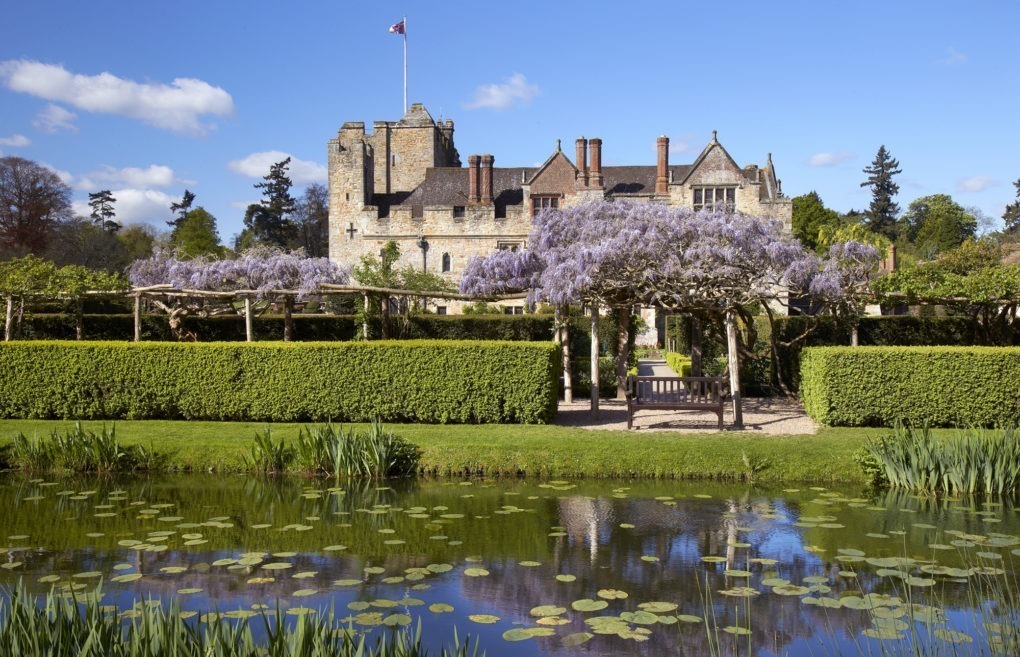

Hooray for May and the growing abundance of purple blooms! For the budding gardener May provides alliums a plenty and the delicate lilac of the wisteria – a favourite plant for me as it heralds the beginning of early summer and hints at the promise yet to come.
Wisteria is a fabulous plant that can hide a multitude of sins if grown upon a pergola or up an unsightly wall.
In the gardens at Hever Castle we are treated to a fabulous display in late spring and early summer. The white blooms on the walls of the Castle are courtesy of Wisteria sinensis ‘Alba’ and we have floribunda ‘Black Dragon’ in the Italian Garden. Wisteria sinensis, is a good species to choose – it looks spectacular as it produces its flowers before its leaves in the spring, it’s also very hardy and grows at an impressive pace.
We have a very productive wisteria on ‘Pergola Walk’ at Hever Castle which was planted in the first decade of the 1900s, around the time the Pergola was erected. ‘Pergola Walk’, designed and commissioned by William Waldorf Astor runs for an impressive 1/8th of a mile from the golden gates beside Half Moon Pond all the way down to the Loggia and lake. The wisteria trails approximately halfway along the structure, climbing clockwise up the struts and sunbathing brazenly upon its roof. The trunks and stems of this mature wisteria require good sturdy support. If you’re thinking of planting one and have longevity in mind then make sure the support you provide is strong. It can cause damage to gutters and downspouts, so, if you decide to plant against the wall of your house, make sure you keep an eye on where the tendrils are going!
Wisteria can be reluctant to bloom before it has reached maturity so it’s a good idea to read about the provenance of your wisteria – some species can make you wait up to 20 years for flowers to bloom! You can avoid disappointment by buying a plant that’s in bloom or choosing a named cultivar.Wisterias are generally fast growing and prefer a moist, well-drained soil. As with our wisteria on ‘Pergola Walk’, they enjoy full sun and will climb until they reach it. It’s a good idea to water in the drier spells from July to September to ensure you will get blooms the following year.
If you’re thinking of investing in a wisteria this year then go for one that has been grown from a cutting or by grafting – wisteria grown from seed aren’t reliable and tend to take a lot longer to flower. Once the plant is a few years old, a relatively compact, free-flowering form can be achieved by pruning in February and again in August.
Apparently the world’s largest known wisteria is in Sierre Madre in California, and stretches for more than 1 acre and weighs in at 250 tons. This mammoth shrub was planted in 1894 and is of the ‘Chinese Lavender’ variety. If you haven’t got an acre to spare for a rabid wisteria, then it is possible to choose dwarf varieties like ‘Amethyst Fall’s which you can grow beside a low wall or in a large pot. This smaller variety has dense clusters of lilac-blue flowers which seemingly drip from the plants twining stems emitting a delicious fragrance that needs to be savoured – so make sure you plant near an entrance or beside a seated area to get the full experience!
Book your visit to Hever Castle & Gardens.
Within the grounds of the Hever Castle Estate, there are two opportunities for you to stay the night with us.
Hever Castle has played host to many important events and celebrations for over 600 years. In 1903 when William Waldorf Astor set about restoring Hever Castle to its former glory, he added the Astor Wing, to accommodate his family and guests, before creating a lake and the spectacular Italian Garden to house his impressive collection of ancient Greek and Roman statuary.
There are multiple places to eat & drink across the Hever Castle Estate. Select between the Castle & Gardens and Golf Club below to discover more.
Set in the mature grounds of the Hever Castle Estate, Hever Castle Golf Club is a 27 hole Kent golf course that will encourage and inspire all golf enthusiasts.
Set in the mature grounds of the Hever Castle Estate, the Wellbeing Centre consists of five smart treatment rooms.